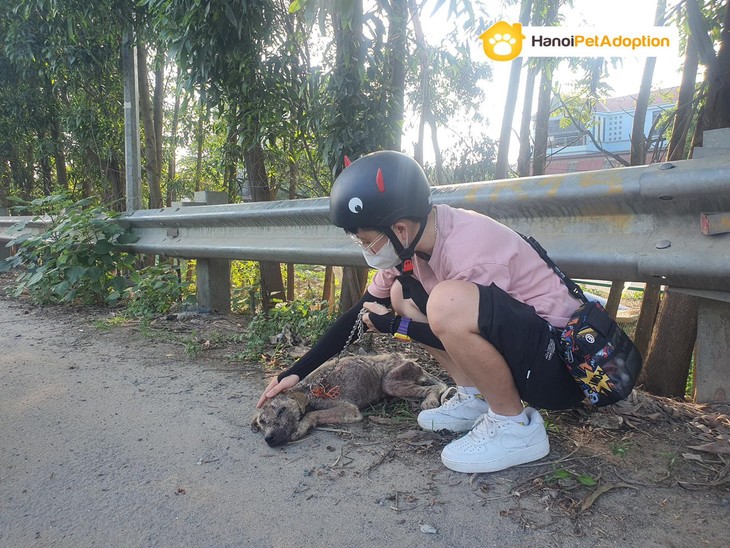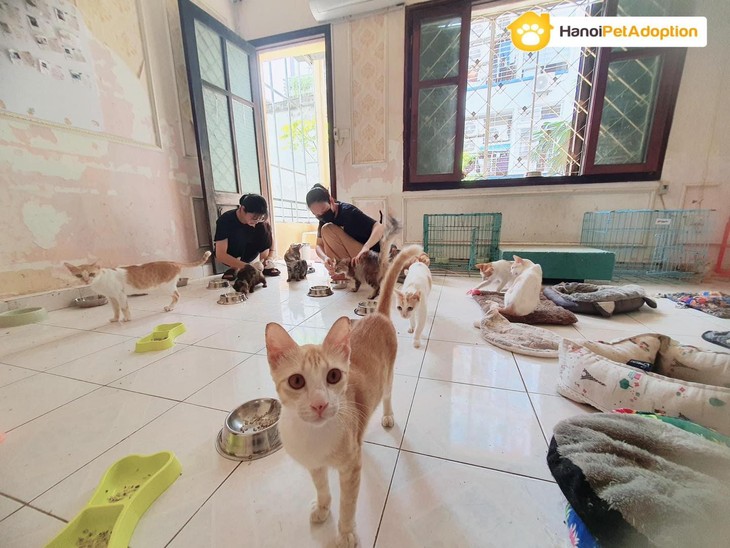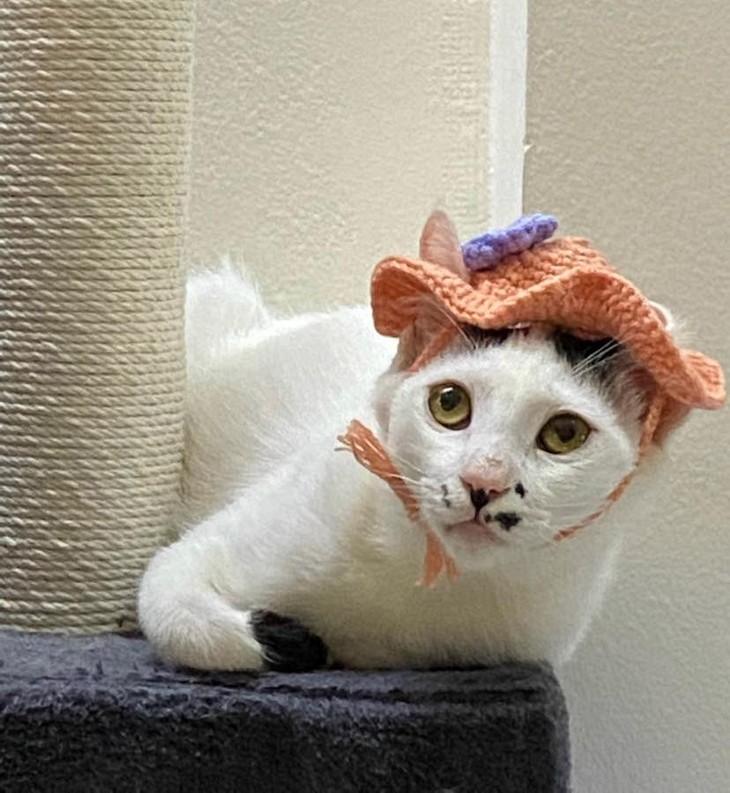 Pham Khanh Quynh rescues a puppy on Thang Long highway in Hanoi. (Photo: Hanoi Pet Adoption official Facebook Fanpage) Pham Khanh Quynh rescues a puppy on Thang Long highway in Hanoi. (Photo: Hanoi Pet Adoption official Facebook Fanpage) |
“When I received a phone call informing us that there was a puppy with scabies abandoned on the Thang Long highway, we immediately made our way there. The puppy was scared and exhausted, and kept barking at us. I gave him some food, which he finished in a few seconds. Then, we cuddled him to show that we wanted to help him. It took us 1 hour to calm him and get him to a vet clinic.”
That was just one of thousands of abandoned dogs and cats that have been rescued by Khanh Quynh and other volunteers of Hanoi Pet Adoption. Nearly every day Quynh receives phone calls or notifications on Zalo or Facebook informing her of stray, abandoned dogs and cats that need help. After a pet is rescued, it is taken to the vet for an examination. If the animal has a serious illness, it is kept at the clinic and treated until it gets better. Every animal must be vaccinated before being brought to the shelter. Then Hanoi Pet Adoption will try to find an adoptive family for them.
Before founding Hanoi Pet Adoption in 2015, Quynh worked at a few dog and cat rescue missions and got to know several vet clinics, animal rescue shelters, and pet lover communities on social media. Her dream was to build the most beautiful and comfortable animal shelter in Vietnam and be able to rescue more abandoned pets. That’s how Hanoi Pet Adoption came into being:p.
“At first, I didn’t have enough space to set up an animal shelter. It took me 2 years to rent a house as a shelter far from any residential area. The initial rent was only 105 USD per month. Thanks to the support of donors, we managed to rent a larger shelter to accommodate the increasing population of rescued cats and dogs. After several moves, this is our sixth home,” said Quynh.
The Hanoi Pet Adoption rescue shelter in Tay Ho district covers 240 square meters and is divided into several sections. One section is for new animals that haven’t yet been vaccinated. A second section is a quarantine area for animals with diseases, and a third section is for healthy animals, who are allowed to roam around.
The shelter is currently home to 100 cats and 30 dogs, half of them suffering from both physical and mental illnesses. They were abandoned for a number of different reasons, Quynh said.
“The cats and the dogs get diseases or are injured due to accidents, requiring the owners to spend a lot of time caring for them and pay high veterinary costs. The pets are dumped either on the street or at a vet clinic. Many pets feel depressed longing for their owners to return.”
“There is also a strange custom that leads to the abandoning of many animals. When a family has a funeral, they feel they need to buy an animal and then release it to draw away the family’s bad luck. We’ve seen several such cases.”
 Rescued cats are taken care of by volunteers. (Photo: HPA Facebook Fanpage) Rescued cats are taken care of by volunteers. (Photo: HPA Facebook Fanpage) |
My Linh, a volunteer at Hanoi Pet Adoption, introduces some abandoned pets at the facility, “This is Bong. This is Bobo. That’s Lu and Lizie. All were abandoned. Bong was bitten by a bigger dog. Her owner took her to the vet clinic and left her there.”
“After being rescued and treated at the clinic, the pets are brought here for further care and treatment. We do our best. Some that have suffered serious disease or injury can live another 4 or 5 years,” said Linh.
The center now has the support of dedicated full-time volunteers and dozens of part-time volunteers who perform different tasks, including posting ads seeking adopters, rescuing animals in need, transporting rescued animals to the vet, and taking care of the animals at the shelter.
To deal with the heavy workload, volunteers must be pet enthusiasts, patient, and dedicated, said Linh.
“I arrive at the shelter early in the morning. I start first with the section for the crippled animals, cleaning the kennels and floor and changing the diapers. After that I cook food for the animals.”
“Then, part-time volunteers come and help us feed the animals and do the cleaning and give medicine to the sick dogs and cats. We have a short noon break. The work is repeated in the afternoon and in the evening. We feed the animals, clean the shelter, and change the diapers again before we go home.”
The volunteers are required to follow the shelter’s strict hygiene regulations to prevent infectious diseases and understand the habits, needs, and health status of each animal to give them the proper care and diet, according to Linh.
“The crippled dogs and cats can’t walk and often have digestive problems. We add some supplementary enzymes to their food. Those who have liver problems should abstain from certain foods.”
Regardless of its circumstance, every pet deserves a decent life. The volunteers do all they can to heal the animals and find a permanent home for them, Quynh said.
“Anyone who wants to adopt a cat or a dog can visit our website athanoipetadoption.com and click on the Adoption section where they can get detailed information about each animal. The adopter then undergoes a screening interview where they must demonstrate financial ability, responsibility, and lifetime commitment to a pet. After the adoption, the adopter and the shelter stay in contact to confirm the status of the adopted pet and exchange information and advice about the animal.”
 HPA promotes communication on animal care at schools. (Photo: HPA Facebook Fanpage) HPA promotes communication on animal care at schools. (Photo: HPA Facebook Fanpage) |
To raise people’s awareness about animal welfare, the group set up Tiktok and YouTube channels to post videos about their rescue work, tips on animal care, and recommendations of vet clinics.
Over the past 8 years, Hanoi Pet Adoption has experienced a lot of financial, personnel, and other problems, but the group’s members are still committed and have no intention of giving up their work, thanks to the many successes they’ve had. Many pets have found new loving homes. Quynh shared with us one of the group’s successes, “Our group received information about an abandoned dog in Dong Anh, Hanoi. A volunteer drove to pick her up right in the middle of the night. She was exhausted, dehydrated, starving, and suffering from severe mange. We took her to a clinic.”
“After treatment, the dog ate well and her skin started to heal. After a few weeks, she became more energetic and looked happier. After the vet discharged her, she was taken in by British foster parents. Before the foster parents went back to England, they made a wonderful decision. They raised donations to help them bring her with them. Now she has a happy, carefree life among the fields, beaches, and forests of England. She’s living up to the name we gave her, Happy.”
The Meo Haus Cat Café in Hanoi is another venue for animal lovers and a cozy home for abandoned cats. The café was opened by Tran Van Anh Hoc, a Vietnamese-American and his wife. Working with Hanoi Pet Adoption, Hoc opened the Meo Haus Cat Café to give stray cats an opportunity to find an adopter.
Meo Haus Cat Café is a four-floor building with a bar, and several cat rooms. For 4 USD a customer can have a drink and play with the cats as long as they wish.
Before entering the cat rooms, customers must wash their hands to avoid spreading diseases to the cats.
 Meo Haus Cat Café attracts young customers. (Photo: Meo Haus Cat Café Facebook Fanpage) Meo Haus Cat Café attracts young customers. (Photo: Meo Haus Cat Café Facebook Fanpage) |
The cat café was opened in March. Hoc, its owner, is an automotive engineer from the US. He came to Vietnam for working, and also hoped to find out more about life in the country.
“The idea came to me out of the blue. My wife and I love animals. When we came to Vietnam, we decided to adopt a cat, so we visited Hanoi Pet Adoption. We felt so sorry to see so many abandoned animals that we thought of doing something to help. I took a house on Pham Hong Thai street and decided to turn it into a cat café. I wanted to create a space for cats and help the adoption process,” said Hoc.
What makes Meo Haus Cat Café different from other cat cafes is that the cats here are stray and abandoned cats that were rescued by Hanoi Pet Adoption. So far, more than 50 cats have come to the café and 10 of them have been adopted.
Luong Cam Tu, an assistant at Meo Haus Cat Café, tells us the story about a cat named Donna.
“We rescued Donna and her two kittens. At the time, Donna had severe scabies. One of her kittens died and the other was adopted. Donna is still here with us. That’s Pobby. Pobby was seen wandering on the street and eating rubbish. He was brought to the cat café. We’re still seeking an adopter for him.”
The café has several assistants who are in charge of feeding the cats, checking their health and looking after them if they get sick. If a cat gets a disease, it’s taken to the café’s quarantine area to prevent the spread of the disease. The assistant helps cats find adopters.
 A cat named "Muoi" has found his adopter. (Photo: Meo Haus Cat Café Facebook Fanpage) A cat named "Muoi" has found his adopter. (Photo: Meo Haus Cat Café Facebook Fanpage) |
“Most of the adopters are foreigners. We contact them through the Zalo app. Before the adoption, the prospective adopter should spend time establishing a connection with the cat they want to adopt and answer questions about their work, financial status, and commitment to adopting a cat. After an adoption, we keep in touch with the adopter to check on the status of the cat and provide tips on pet care,” Tu said.
Anh Hoc says the café requires a lot money and time to run, but he thinks it’s worth it. Since he opened the café, many cats have found a new home, which is encouraging to him.
“I’ve spent a lot of my savings and time on this café, but I don’t regret it. Many people open a café to make money, but I wanted to open Meo Haus Cat Café as a home for abandoned cats and to give them a chance to meet an adopter and find a permanent home.”
Meo Haus Cat Café attracts customers of all different ages, who come to enjoy a drink, play with the cats, and maybe adopt one.